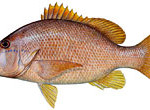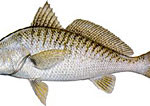
Scombridae
The Scombridae family of tuna and mackerel are fast-swimming, wide-ranging pelagic fishes. They have a number of special adaptations for this lifestyle, including a streamlined body form and recessible dorsal and anal fins. Some species are partly endothermic, maintaining a higher body temperature in the swimming muscles. Scombrids often swim in schools and prey on other fishes. Many species are very important as sport fishes and in commercial harvest.
Albacore (Thunnus alalunga) can be distinguished from other tunas by a long pectoral (breast) fin that may reach to a point beyond the anal fin. Albacore are devoid of any stripes or spots on lower flanks and belly. The tail fin has a thin white trailing edge and there is on yellow colouring on the main fins, but the dorsal finlets are yellowish. The anal finlets are silvery or dusky. Maximum adult length is 140cm.
Northern bluefin tuna (Thunnus thynnus) is the largest member of the family that you are likely to see in the region. It has a fusiform (cigar shaped) body, compressed and stocky in front. The back and upper sides are dark blue to black with a gray or green iridescence. The lower sides are silvery, marked with grey spots and bands. The 2nd dorsal (back) fin is reddish-brown, and the anal fin is dusky with some yellow. The finlets are yellow, edged with black. Maximum adult length is 450cm.
Skipjack tuna (Katsuwonus pelamis) can be distinguished from other tunas by the presence of stripes on the belly. There are normally between 4 and 6 prominent, dark longitudinal stripes from lower belly and sides toward the tail. The top of the fish is a dark purplish-blue and the lower flanks and belly are silvery. Maximum adult length is 105cm.
Bigeye tuna (Thunnus obesus). A stocky body and large eyes are characteristic of this species. The pectoral fin reaches 2nd dorsal fin. Thefirst dorsal fin is deep yellow, with the second dorsal and the anal fins being brownish or yellowish with narrow black edges. Finlets are yellow with dark edges. A lateral iridescent blue band runs along the sides. Maximum adult length is 105cm.
The Atlantic bonito tuna (Sarda sarda) can be distinguished from other tunas by the presence of seven or more (often 9-12) oblique dark stripes on the dorsal side of the fish. The back of the fish is steel blue or blue-green and the flanks and belly are silvery to whitish. The body is entirely covered with scales, which are very small except in the pectoral region. Bonito have large conical teeth on both the upper and lower jaw. Maximum adult length is 105cm.
The little tunny (Euthynnus alletteratus) is found worldwide in tropical to temperate waters, between 56°N-30°S. In the western Atlantic Ocean, it ranges from Massachusetts (US), south to Brazil, including the Gulf of Mexico, Caribbean Sea, and Bermuda. It is the most common member of the Scombridae family in the western north Atlantic. It is distinguished by a scattering of dark spots, usually 4-5, resembling fingerprints between the pectoral and ventral fins. This species also has wavy markings found on the back above the lateral line, located within a well-marked border that never extends further forward than the middle of the first dorsal fin. The teeth are small and conical. Maximum adult length is 120cm.
The Atlantic mackerel (Scomber scombrus) is probably the most recognised of the numerous species of mackerel. This beautiful fish has a bright green body with many dark stripes that run in an irregular pattern. A type of luminous effect is found on the sides and under parts of this fish that give it a reddish reflection. Atlantic mackerel feed mostly on sardines, young herring, anchovies and small crustaceans. Mackerel travel in large schools on both sides of the
Atlantic Ocean. In the Northwest Atlantic, they range from northern Carolina to southern Labrador. In the eastern Atlantic, they are found off Iceland and northern Norway. Noted as a delicious food fish, Europeans harvest them by freezer trawlers, whilst the purse seine is the harvest method of choice for North American fishermen (a purse seine is a large vertical, weighted net designed to be set by two boats around a school of fish and then pulled closed at the bottom by means of a line).
One of the more amazing characteristics of the mackerel is their ability to speedily dive when threatened by a predator. The lack of a swim bladder makes it possible for them to move into deep waters almost as quickly as the predator appears. Predators include dolphins, tuna and sharks. Maximum adult length is 60cm.
Other species that you might encounter whilst diving in the region are shown below. The approximate maximum adult size is also included in the list:
- Blackfin Tuna Thunnus atlanticus 105 cm
- Bullet Tuna Auxis rochei rochei 50 cm
- Frigate Tuna Auxis thazard thazard 65 cm
- Yellowfin Tuna Thunnus albacores 230 cm
- Cero Scomberomorus regalis 180 cm
- Chub Mackerel Scomber japonicus 64 cm
- King Mackerel Scomberomorus cavalla 180 cm








Social Profiles